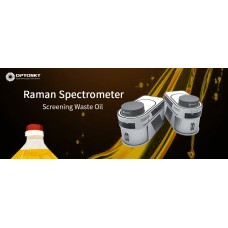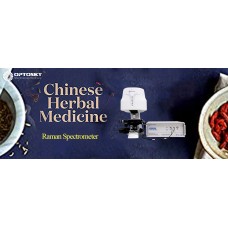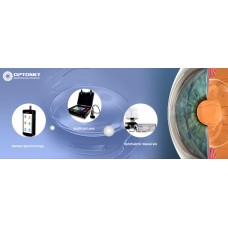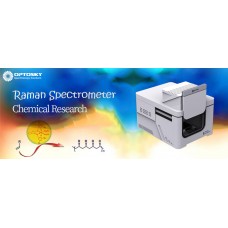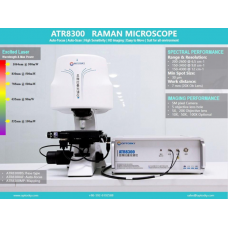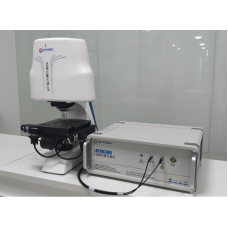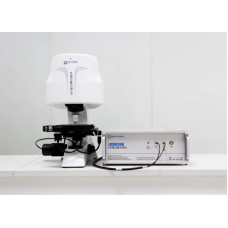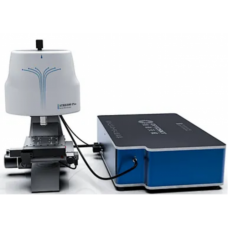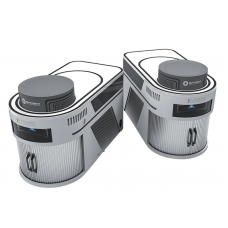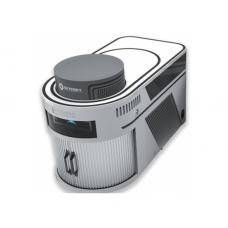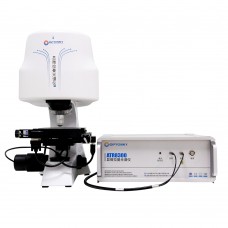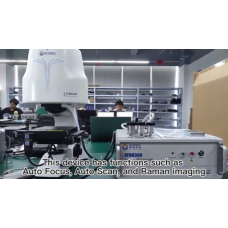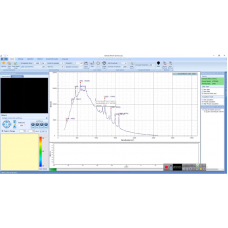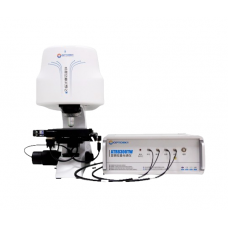The ATR8800 series scientific-grade confocal Raman imaging microscope. This is a confocal Raman imaging microscope self-developed successfully first-launched in China market in 2022. It provides wavelengths of 266 nm, 325 nm, 514 nm, 532 nm, 638 nm, 785 nm, 830 nm, 1064 nm for combination selection, one-band, dual-band, triple-band, or quadri-band offers free selection and conbination to satisfy any scientific-grade research requirements. It uses confocal technique of pinhole to improve spatial resolution with a minimum spot size up to 1.6μm, and result in trace material measure.
Auto-focus and Auto-scan Raman imaging microscope features super sensitivity, super fast scan, and excellent resolution of 0.5cm-1.Confocal Raman microscopy can combine Raman spectroscopy with microscopy technique to measurer trace micron specimen less than 2 sceonds.
The exclusive designed seal sample compartment is an ideal for any experiment on the daytime, push and pull seal door can start measurement w/o turning off light in the lab.
The free software provides a powerful function of multiple band splicing large area imaging data.
| Instrument | |
| Optional Detector | 1) Deep cooling CCD: 2000X256 pixels 2) Deep cooling CCD: 1600X200 pixels 3) Deep cooling InGaAs : 512X1 pixels Up to 2 detectors can be integrated, choose one of detector 1# and detector 2#; |
| Excitation wavelength | Max. 4 lasers of 266,325, 532,638,785,1064 nm |
| Laser | |
| Laser Spot Diameter | >1μm |
| Laser Stability | σ/μ <±0.2% |
| Laser Power | 266nm:30 mW 325nm: 30mW 532nm:100mW 633nm:80mW 638nm:80mW 785nm:350mW 1064nm:500mW |
| Focus | Confocal |
| Microscope Camera | 5-mega pixels industrial camera |
| Laser Output | 266nm:30 mW 325nm: 30mW 532nm:100mW 633nm:80mW 638nm:80mW 785nm:350mW 1064nm:500mW |
| Objective lens | Standard configuration:4X,10X,20X,50X; Optional configuration:100X |
| Microscopic illumination | High brightness long life white light LED |
| Lighting method | Epi Illuminiation |
| Stage | |
| X/Y Axis Moving Range | 50 X 50 mm,100X100mm optional |
| X/Y Axis Moving Resolution | 0.1 μm |
| X/Y axis Positioning Accuracy | 1 μm |
| X/Y axis Scanning Speed | 20 mm/s |
| Z Axis Focus Accuracy | ≤ ±0.2 μm |
| Z axis Focus Speed | < 10 s |
- Automatic Raman imaging experiment, Auto-focus, Auto-scan
- Confocal light path
- 4 excitation wavelengths support.
- Long focal length
- Ultra-high sensitivity, SNR >6000:1;
- Rotated grating
- Closed hatch
- Imaging range (100×100mm), automated imaging splicing
- Unique software controls switching light path.
- Quick positioning and focus;
- High-quality objective lens, Micron-level light spot;
- 5 million pixel cameras with clear image
- Interface : USB3.0
- Automatic Raman imaging experiment, Auto-focus, Auto-scan
- Confocal light path
- 4 excitation wavelengths support.
- Long focal length
- Ultra-high sensitivity, SNR >6000:1;
- Rotated grating
- Closed hatch
- Imaging range (100×100mm), automated imaging splicing
- Unique software controls switching light path.
- Quick positioning and focus;
- High-quality objective lens, Micron-level light spot;
- 5 million pixel cameras with clear image
- Interface : USB3.0
- Nanoparticles And New Materials
- Universities And Research Institutes
- Biotechnology : Biological Sciences
- Biopharma : Forensic Medicine Identification
- Material Science
- Chemistry : Medical Immunoassay
- Agriculture And Food Identification : Food & Beverage
- Water Pollution Analysis
ATR8800 Model No. Rules:
ATR8800AF-LT-FL350-532+633:
AF: Auto Focus
LT: long integration time
FL: Focal length: 350mm
Dual-band: 532nm & 633nm
ATR8800MP-SCM-FL760-532+633+1064:
Scanning Imaging: SCMOS Detector
Focal Length:760mm
Triple-Band: 532nm, 633nm and 1064nm
Model | Focus length | Excitation wavelength /nm | Laser power /mW | Maximum wave number range | Miniature resolution/cm-1 |
ATR8800-FL350 | 350mm | 532 | 100 | 200 ~ 3700 | 1.4 |
633/638 | 80 | 200 ~ 3500 | 1.4 | ||
785 | 350 | 200 ~ 3500 | 2.1 | ||
1064 | 500 | 200 ~ 2500 | 5.2 | ||
ATR8800-FL510 | 510mm | 532 | 100 | 200 ~ 3700 | 0.9 |
633/638 | 80 | 200 ~ 3500 | 0.9 | ||
785 | 350 | 200 ~ 3500 | 1.4 | ||
1064 | 500 | 200 ~ 2500 | 3.6 | ||
ATR8800-FL760 | 760mm | 532 | 100 | 200 ~ 3700 | 0.5 |
633/638 | 80 | 200 ~ 3500 | 0.5 | ||
785 | 350 | 200 ~ 3500 | 1.0 | ||
1064 | 500 | 200 ~ 2500 | 2.7 | ||
ATR8800LT:3rd stage cooling to -30℃, long integration time (up to 1.3h) ATR8800SCM:Te-Cooled SCMOS detector ATR8800BS:Basic series ATR8800AF:Auto-focus ATR8800MP:Scan imaging-Mapping, Auto-focus | |||||
- Optosky has been developing Raman spectrometer for 20-year.
- Optosky is China National Standards drafter of Raman spectrometer
- Top 1 in China brand and Top 3 brand in the world.
In 2016 launch the first generation handheld Raman spectrometer, - In 2017 launch the dual-band Raman spectrometer
- In 2020, launch the triple-band Raman microscope
- In 2021, launch the quadriband scientific-grade Raman microscope
- Optosky represents the highest performance cost less Chinese high-tech manufacturers with industry-leading warranty guarantee and technical support.
- Optosky's Raman spectroscopy technology originate from Shanghai Institute of Technical Physics Chinese Academic of Science University and Xiamen University Zhong Qun Tian who discovers SHINERS makes SERS can be preserved longer than 2 years.
- Quality control system follows Agilent Technologies
- 60% R&D engineers provide Industrial-leading warranty guarantee and technical support services
- The most experienced engineers and 3 Drs team in Raman spectroscopy
- Complete certification of ISO, CE, FDA Approval, Police Approval, API Approval
Q: Why the 1064nm Raman can resist high fluorescence materials?
A: 1064nm belong to NIR photon has a low frequency, low energy is seldom absorbed by the sample molecule, and it's difficult to excite ground state electron as well as fluorescence, so that it prevent fluorescence from generation.
Q: Why Raman signals are easily annihilated by fluorescence?
A: Fluorescence intensity is about 10^6 times stronger than that of Raman signal. traditional Raman signals are easily annihilated by fluorescence.
Q: Which materials have high fluorescence recommended to use 1064nm Raman?
A: Such as Heroin, Fentanyl, Colour samples, Biological samples, Textiles, Bacteria, Drugs, Fuel, Petroleum samples, Vegetable oils, Explosives, Plastic.
How many methods can remove fluorescence interference?
1st, Baseline correction uses an algorithm to remove fluorescence interference.
2nd, Difference Raman uses two wavelengths of lasers (eg: 784.5nm+785.5nm) to excite samples can obtain two sets of Raman signal and calculate the difference to obtian the spectrum without fluorescence.
3rd, Time gate control method
4th Fluorescence photobleaching method
5th, 1064nm Raman spectrometer is highly recommended

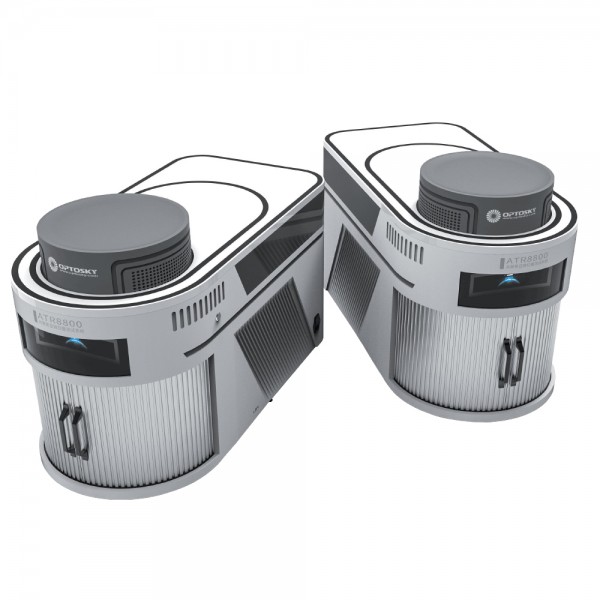











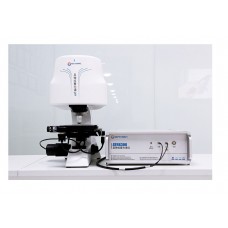

-228x228.png)
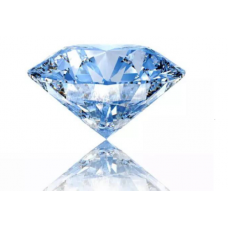
-228x228.png)
